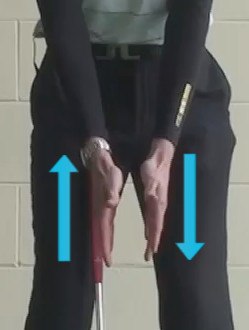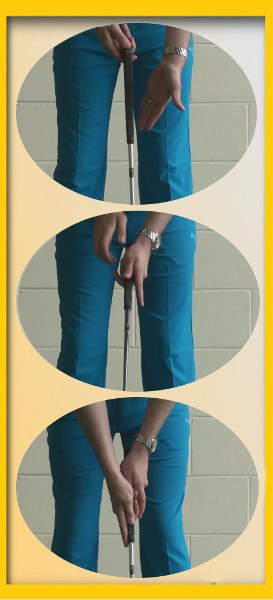
The hands must be unified to ensure a sound putting stroke. That's why the grip is all-important.
Regardless of how you hold the club – with a reverse-overlap or 10-finger grip, for example – the palms should face each other directly. Check this by taking your normal putting grip, then unlocking both hands so they're flat against either side of the handle. Are your palms parallel?
A good way to get the feel for a palms-facing grip is with a standard ruler. Hold it between your hands, both palms flat against the sides, then curl the fingers around the ruler as though it were a putter.
When the hands are in harmony, your putting stroke will be too. Your putting can improve dramatically when you use a grip that features flat palms. No, just using this grip is not going to instantly make you a better putter, but it should send you in the right direction. If you can blend this grip together with a number of other solid fundamentals, you will be pleased with the long-term results.

Flat Palms Key to Proper Putting Grip?
It is common for golfers to spend plenty of time working on the grip they use to make full swings. Your grip is obviously the only point of contact between your body and the club, so it is important to get this interface just right. With a quality grip, you can effectively transfer power from your body down into the club – and eventually, into the ball. A poor grip, on the other hand, is going to hinder your best efforts to hit solid shots. Even if the rest of your swing technique is in excellent condition, you may find yourself struggling to play well if you have an improper grip.
In this article, we are going to focus on the grip, but not the one you use in your full swing. Instead, we are going to discuss your putting grip. Just as is the case in the full swing, the putting grip is an important piece of the overall golf puzzle. You already know that it is important to make as many putts as possible each round – but did you know how important your grip is in that process? Without a good grip, it is always going to be difficult to roll the ball accurately toward the cup. Putting is a big enough challenge as it is, you don't need to make it any harder by making mistakes when placing your hands on the handle.
As you can see from the title of this article, we are going to be talking about the position of your palms when you form your grip. The term 'flat palms' refers to creating a grip that has the palms facing each other on opposite sides of the grip while you swing the putter. This is a popular method, but is it the key to forming a great grip? We will look at this question, and much more, in the content below.
Before reading on, it is important to note that there are many different factors which need to come together successfully if you are going to hit great putts on a consistent basis. Yes, working on your grip is a great place to start, but this can't be the end of the journey. You will need to work on a variety of other keys, such as your stance, stroke mechanics, green reading skills, and more. Putting might look simple, but any experienced golfer will know that nothing could be further from the truth. It will take time, attention to detail, and plenty of practice for you to learn how to putt at a high level.
All of the content below is based on a right-handed golfer. If you happen to play left-handed, please take a moment to reverse the directions as necessary.

The Benefits of Flat Palms
As you will see in this section, there is a lot to be gained when you place your hands in a position on the grip that allows the palms to face one another. This is not a grip which would work in the full swing, as it limits wrist movement too severely. It is perfect for putting, however, because of exactly that trait. Without the ability to move your wrists freely during the stroke, you will be left to rock the putter back and forth with your shoulders. This is as it should be, and your putting performance will be better for it.
The following list highlights some of the biggest advantages to be gained by using flat palms in your putting grip.
- Quiet wrists. We jumped the gun on this first point, as it was discussed above. However, it is important enough to mention twice before moving on. You don't want to have your wrists actively involved in the putting stroke, as they are going to make it difficult to manage both the direction and speed of your putts. It is necessary to use your wrists actively on many other shots in the game of golf, as they can help you create clubhead speed effectively. You don't need to create much clubhead speed on the greens, so that point is not relevant here. By setting your palms flat on opposite sides of the grip, you can make it easy to pass control of the stroke into your shoulders. Simply put, you aren't going to get very far on the greens until you learn how to keep your hands and wrists quiet. Mastering a flat palms grip will be a big help in this pursuit.
- Connection between the two hands. This is an important point – you need your hands to be working together during the stroke. If your palms are not facing each other, you will likely struggle to gain a good feel for the putter as it moves, because each hand will be trying to do its own thing. When your palms match up and your grip comes together nicely around the handle, you will have the kind of cohesion you need to roll the ball beautifully. If your current putting stroke feels awkward and forced, there is a good chance that your grip is to blame.
- Accurate speed control. As you know, controlling the speed of your putts is a vital skill. If you can't control your speed effectively, you will never be able to lower your scores on a consistent basis. This type of grip will help you learn how to control your putts properly because it is going to lead to a more consistent swing of the putter through the impact zone. Of course, just the grip alone is not going to allow you to master your distance control, so you'll need to spend plenty of time practicing as well. Before you start any round, try to spend at least a few minutes on the practice green getting comfortable with the pace of the surfaces for the day.
- A clean strike. This is something that you may not think much about when hitting a putt. It doesn't seem like much of a challenge to hit your putts cleanly, as you aren't making a big swing down into the turf like you do with an iron shot, for example. However, it is just as important to hit your putts cleanly as it is to catch your irons on the sweet spot. When you hit a putt perfectly in the middle of the face, you will stand a good chance to hit your line and get your speed right as well. By mastering this type of grip, the club is going to be stable through impact and you should be able to find the sweet spot with regularity.

How to Place Your Hands on the Grip
When it comes to forming your grip, it's all about the details. You can't afford to get sloppy here, as missing the mark just slightly could lead to poor results. It isn't particularly difficult to place your hands properly on the putter, but it isn't going to happen by accident, either.
To make sure you wind up with an excellent grip to serve as the foundation of your putting stroke, we have put together the step-by-step directions below. Follow these steps and there is a good chance you'll wind up with a beautiful putting grip just moments from now.
- To get started, you will need your putter – and that's it. You can be at the golf course while working on learning this grip, or you can be at home. It really doesn't matter, as all we are going to do here is work on mastering the grip.
- Hold the putter in your right hand casually while you settle into a putting stance. At this point, your right hand should be lower on the grip than it will be in the final version of your grip. Set the club head down on the ground behind the ball – or behind an imaginary ball, if you are just doing this at home – and make sure your stance is comfortable. You actually want to set your body before you set your hands.
- Now that your body is set, go ahead and start to create your grip. With your right hand still holding onto the club in a temporary position, you are going to start the process by adding your left hand to the left side of the grip. Your palm should be facing to the right, as if you were shaking hands with the putter. With your palm pressed up against the side of the handle, place your thumb perfectly on top of the grip and wrap your fingers around the back. Just like that, you will have your left hand in a perfect position.
- With your left hand in place, you can now move your right hand into position to complete the grip. This should be pretty simple, as you are going to focus on matching it up with your left hand so that the palms are facing one another directly. You can choose to bring the hands together in a number of ways, but the 'reverse overlap' method is the most popular. With this grip, you will place the pointer finger on your left hand on top of the ring finger on your right hand. Just like your left, your right thumb should be directly on top of the grip.
- At this point, your grip is complete and you are ready to make a stroke. If you are just working on your grip at home, it may be helpful to repeat this process several times just to get comfortable adding and removing your hands. If you are at the course, go ahead and hit a few putts with your hands in place before repeating the process.
It might seem a little time consuming to work through the steps above each time you need to grip the putter, but you will get faster and faster as you continue to practice. Pretty soon, you won't really need to think about the steps at all – you will just form your grip while thinking about the line and speed you are going to use for the putt. Invest some time during practice making sure this grip is comfortable so it can be an automatic part of your game when you get back out onto the course.






